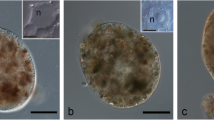Abstract
The sulfur inclusions from four strain ofBeggiatoa alba were observed by using a ruthenium red-glutaraldehyde technique and a modified Ryter-Kellenberger technique. Three of the four strains contained 4-to 5-nm-thick, single, electron-dense, layered sulfur inclusion envelopes. The fourth strain (B15LD) contained a complex pentalaminar sulfur inclusion envelope, 12–14 nm thick. The sulfur inclusions from all four strains were external to the cytoplasmic membrane but internal to the complexBeggiatoa cell walls. Freeze-etching of theB. alba strain B18LD trichomes revealed the unusual cross-fracture morphology of the sulfur in the inclusions. Fractures around the sulfur inclusions revealed a surface similar to that of the fractured cytoplasmic membrane.
Similar content being viewed by others
Literature Cited
Bland, J. A., Staley, J. T. 1978. Observations on the biology ofThiothrix. Archives of Microbiology117:79–87.
Cannon, G. C., Strohl, W. R., Larkin, J. M., Shively, J. M. 1979. Cytochromes inBeggiatoa alba. Current Microbiology2:263–266.
Drawert, H., Metzner-Küster, I. 1958. Fluorescenz und elektronmikroskopische Untersuchung anBeggiatoa alba undThiothrix nivea. VI. Mitteilung der Reihe: Zellmorphologische und zellphysiologische Studien an Cyanophyceen. Archiv für Mikrobiologie31:422–434.
Dunlop, W. F., Robards, A. W. 1973. Ultrastructural study of poly-β-hydroxybutyrate granules fromBacillus cereus. Journal of Bacteriology114:1271–1280.
Hageage, G. J., Jr., Eanes, E. D., Gherna, R. L. 1970. X-ray diffraction studies of the sulfur globules accumulated byChromatium species. Journal of Bacteriology101:464–469.
Lawry, N. H., Jani, V., Jensen, T. E. 1981. Identification of the sulfur inclusion body inBeggiatoa alba B18LD by X-ray energy-dispersive microanalysis. Current Microbiology6:71–74.
Maier, S., Murray, R. G. E.. 1965. The fine structure ofThioploca ingrica and a comparison withBeggiatoa. Canadian Journal of Microbiology11:645–656.
Morita, R. Y., Stave, P. W. 1963. Electron micrograph of an ultrathin section ofBeggiatoa. Journal of Bacteriology85:940–942.
Nicolson, G. L., Schmidt, G. L. 1971. Structure of theChromatium sulfur particle and its protein membrane. Journal of Bacteriology105:1142–1148.
Remsen, C. C. 1978. Comparative subcellular architecture of photosynthetic bacteria pp. 31–60. In: Clayton, R. K., Sistrom, W. R. (eds.), The photosynthetic bacteria. New York: Plenum Press.
Reynolds, E. S. 1963. The use of lead citrate at high pH as an electron opaque stain in electron microscopy. Journal of Cell Biology17:208–212.
Schmidt, G. L., Nicolson, G. L., Kamen, M. D. 1971. Composition of the sulfur particle ofChromatium vinosum strain D. Journal of Bacteriology105:1137–1141.
Shively, J. M. 1974. Inclusion bodies in prokaryotes. Annual Reviews of Microbiology28:167–187.
Spurr, A. R. 1969. A low-viscosity epoxys resin embedding medium for electron microscopy. Journal of Ultrastructural Research26:31–43.
Strohl, W. R. 1979. Ultrastructure ofCytophaga johnsonae andC. aquatilis by freeze-etching. Journal of General Microbiology112:261–268.
Strohl, W. R., Larkin, J. M.. 1978. Cell division and trichome breakage inBeggiatoa. Current Microbiology1:151–155.
Strohl, W. R., Larkin, J. M. 1978. Enumeration, isolation, and characterization ofBeggiatoa from freshwater sediments. Applied and Environmental Microbiology36:755–770.
Strohl, W. R., Larkin, J. M., Howard, K. S. 1978. Characterization and ultrastructure ofBeggiatoa sulfur inclusions. Abstracts of the Annual Meeting of the American Society for Microbiology1978:77.
Strohl, W. R., Howard, K. S. Larkin, J. M. 1981. Ultrastructure ofBeggiatoa alba strain B15LD. Journal of General Microbiology, in press.
Tredway, J. V., Lee, J. D., Burton, S. D. 1977. Morphological evaluation of the ultrastructure of marine and freshwaterBeggiatoa species. Abstracts of the Annual Meeting of the American Society for Microbiology1977:240.
Watson, M. L. 1958. Staining of tissue sections for electron microscopy with heavy metals. II. Applications of solutions containing lead and barium. Journal of Biochemical and Biophysical Cytology4:475–479.
Wirsen, C. O., Jannasch, H. W. 1978. Physiological and morphological observations onThiovulum sp. Journal of Bacteriology136:765–774.
Author information
Authors and Affiliations
Rights and permissions
About this article
Cite this article
Strohl, W.R., Geffers, I. & Larkin, J.M. Structure of the sulfur inclusion envelopes from four beggiatoas. Current Microbiology 6, 75–79 (1981). https://doi.org/10.1007/BF01569007
Issue Date:
DOI: https://doi.org/10.1007/BF01569007




